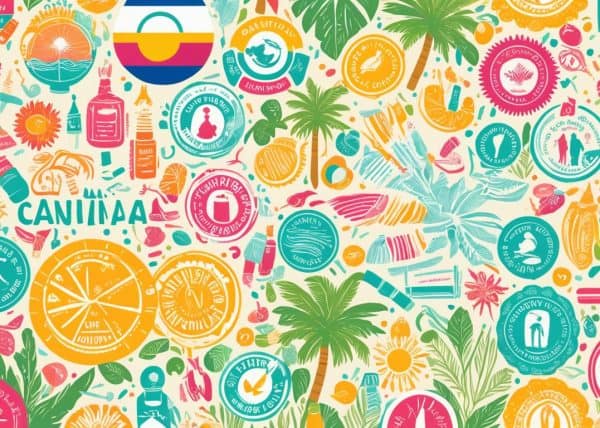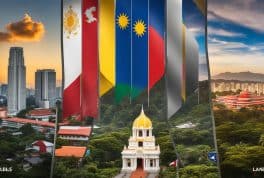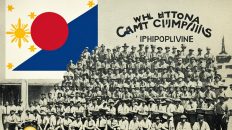Discover Intriguing Philippines Facts and Insights
Are you ready to explore the fascinating world of the Philippines? Prepare to be captivated by a country that is filled with amazing wonders and unique cultural heritage. From stunning landscapes to vibrant traditions, the Philippines offers a treasure trove of surprises waiting to be uncovered. But did you know that there's more to this archipelago than meets the eye?
Get ready to delve into a world of interesting facts about the Philippines, where every corner has a story to tell. From its geography and history to its rich cultural heritage, there's something for everyone to discover. So, are you ready to uncover the hidden gems and important information about the Philippines that will leave you amazed?
Key Takeaways:
- Discover intriguing facts about the Philippines' geography, history, and culture.
- Learn about the unique natural resources and wildlife found in the country.
- Explore the vibrant food scene and famous landmarks of the Philippines.
- Uncover surprising insights into the technology, communication, and sports in the country.
- Plan your visit to the Philippines and experience the beauty and charm of this remarkable nation.
Geographic Facts about the Philippines
The Philippines, located in Southeast Asia, is a captivating archipelago composed of 7,641 islands, making it one of the largest archipelagos in the world. With such a vast expanse of land and water, the geography of the Philippines offers a diverse range of landscapes and natural wonders.
- Luzon and Mindanao: The two largest islands, Luzon and Mindanao, make up two-thirds of the total land area of the Philippines.
- Island Inhabitance: Interestingly, only about one-third of the countless islands in the archipelago are inhabited.
- Strategic Location: Strategically located between the South China Sea and the Pacific Ocean, the Philippines boasts a location that contributes to its unique topography and climate.
- Nature's Beauty: The country is blessed with stunning beaches, majestic mountains, active volcanoes, and lush rainforests.
- Flora and Fauna: The diverse ecosystems of the Philippines are home to a rich variety of flora and fauna, including vibrant orchids, mischievous monkeys, playful squirrels, intriguing lemurs, and countless species of colorful birds.
"The Philippines is a natural paradise, where each island offers a different glimpse into the wonders of nature. From white sandy beaches to mystical rainforests, it's a destination that truly has it all."
To get a better understanding of the geography of the Philippines, take a look at the following table:
| Aspect | Details |
|---|---|
| Total Land Area | 115,831 square miles (300,000 square kilometers) |
| Number of Islands | 7,641 islands |
| Main Islands | Luzon, Visayas, Mindanao |
| Highest Mountain | Mount Apo (9,692 feet or 2,954 meters) |
| Longest River | Cagayan River (230 miles or 373 kilometers) |
With its awe-inspiring landscapes and diverse ecosystems, the geography of the Philippines invites exploration and adventure. From the breathtaking beaches of Palawan to the majestic slopes of Mount Mayon, there is no shortage of natural beauty to discover in this remarkable archipelago. So pack your bags and get ready to immerse yourself in the wonders of the Philippines' geography.
Historical Facts about the Philippines
The Philippines has a fascinating history that spans centuries. It all began with the arrival of Ferdinand Magellan in 1521, marking the first European contact with the islands. In honor of Philip II of Spain, the country was named the "Philippines."
For over 300 years, the Philippines was a Spanish colony, with Spain ruling the archipelago and leaving a lasting impact on its culture and traditions. However, in 1898, after the Spanish-American War, the Philippines was granted to the United States.
In 1935, the Philippines became self-governing, but its journey to independence was hindered by the outbreak of World War II and the invasion of Japanese troops. It was not until 1944-45 when U.S. forces liberated the islands, leading to the proclamation of the Republic of the Philippines in 1946.
Since gaining independence, the Philippines has experienced periods of martial law and democratic rule, undergoing significant political and social changes. The country continues to evolve, shaped by its rich history and the resilience of its people.
Spanish Colonization of the Philippines Timeline
| Year | Event |
|---|---|
| 1521 | First European contact with the arrival of Ferdinand Magellan |
| 1565 | Establishment of the first Spanish settlement in Cebu |
| 1571 | Foundation of Manila, the capital of the Spanish East Indies |
| 1898 | Philippines granted to the United States after the Spanish-American War |
| 1935 | Philippines becomes self-governing |
| 1944-45 | U.S. forces liberate the Philippines |
| 1946 | Proclamation of the Republic of the Philippines |
Throughout its history, the Philippines has undergone significant changes, emerging as a diverse and resilient nation. The Spanish colonization left a lasting legacy evident in aspects of Filipino culture, including language, religion, and architecture.
Cultural Facts about the Philippines
The Philippines is a country known for its vibrant and diverse culture, shaped by a combination of colonization and indigenous traditions. Here are some interesting cultural facts about the Philippines:
- Filipino Cuisine: Filipino food is a reflection of the country's cultural diversity. Traditional dishes like adobo, sinigang, and lechon showcase a blend of flavors influenced by Spanish, Chinese, and Malay cuisines. Filipino cuisine is characterized by its bold and savory flavors.
- Love for Music and Singing: Music plays a central role in Filipino culture. Karaoke is a beloved pastime, with Filipinos enthusiastically showcasing their singing talents. Singing is embedded in various social gatherings, from casual family gatherings to lively karaoke nights with friends.
- Emphasis on English Education: The Philippines is one of the largest English-speaking countries in the world. English is widely spoken and used in schools, businesses, and government institutions. The country's strong emphasis on English education has made it a hub for English language learning.
- Hospitality and Respect for Elders: Filipinos are known for their warm hospitality and respect for elders. Terms like "ate" (for older sister) and "kuya" (for older brother) are used to address older siblings or elders, showing reverence and a sense of familial closeness.
- Superstitions: Superstitions play a significant role in Filipino culture. Various beliefs and practices influence daily life and celebrations. For example, the belief in "pagpag" (shaking off bad luck) before entering one's home and the tradition of avoiding sharp objects during New Year's celebrations are just a few examples of the superstitions observed by Filipinos.
The rich cultural heritage of the Philippines is deeply rooted in its historical background, weaving together a tapestry of traditions, values, and customs. Whether it's savoring the flavors of Filipino cuisine, immersing oneself in the world of music and singing, or embracing Filipino hospitality, there's no shortage of cultural wonders to be discovered in the Philippines.
"Filipino cuisine is a fusion of flavors influenced by Spanish, Chinese, and Malay cuisines, resulting in dishes that are rich, flavorful, and diverse."
Filipino Cuisine: A Delicious Fusion
| Dish | Description |
|---|---|
| Adobo | A popular Filipino dish made with meat (typically chicken or pork), simmered in a mixture of soy sauce, vinegar, garlic, and spices. |
| Sinigang | A sour soup typically made with pork, beef, or shrimp, combined with vegetables like kangkong (water spinach), eggplant, and radish. |
| Lechon | A whole roasted pig, often served as the centerpiece of festive occasions. The skin is crispy, and the meat is tender and flavorful. |
These are just a few examples of the mouthwatering dishes that embody the cultural fusion of Filipino cuisine. Exploring the diverse flavors of traditional Filipino food is a delightful journey through the country's culinary heritage.
Unique Facts about the Philippines
The Philippines is a country filled with unique aspects that set it apart from other nations. Let's explore some of the most fascinating and unusual facts about this beautiful archipelago.
"The Philippines is a treasure trove of hidden gems just waiting to be discovered."
The Iconic Jeepney
One of the most recognizable symbols of Filipino culture is the jeepney. These colorfully painted buses have become an integral part of daily life in the Philippines. Originally repurposed military jeeps from World War II, jeepneys are now a common mode of transportation for locals and a unique sight for tourists.
The Majestic Philippine Eagle
The Philippines is home to the endangered Philippine eagle. With its striking appearance and powerful wingspan, this magnificent bird is often referred to as the "King of the Birds." It can be found in the rainforests of the Philippines, particularly in Mindanao and Luzon.
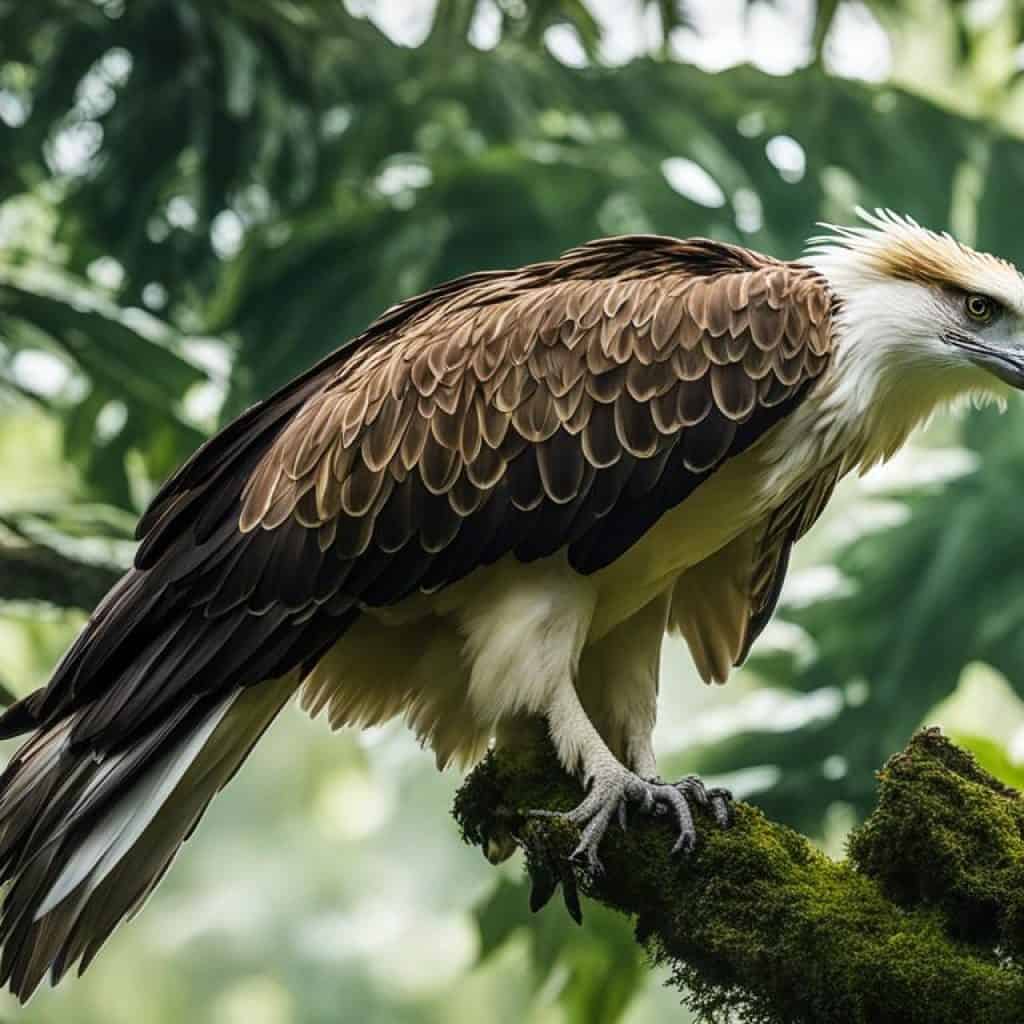
The Largest Supplier of Nurses
The Philippines is renowned for producing highly skilled healthcare professionals. In fact, it is the largest supplier of nurses worldwide. Many Filipinos pursue nursing careers and seek employment opportunities abroad due to limited job prospects locally. Their dedication and expertise make them highly sought after in the global healthcare industry.
The Puerto Princesa Subterranean River
Located in Puerto Princesa Subterranean River National Park, the Philippines is home to the Puerto Princesa Underground River. This majestic underground river is the longest navigable underground river in the world, spanning approximately 8.2 kilometers. It is recognized as a UNESCO World Heritage Site and is a must-visit destination for nature enthusiasts.
Unique Transportation Modes
In addition to the iconic jeepney, the Philippines boasts a variety of unique transportation modes. Tricycles, motorized tricycles with sidecars, can be found in many cities and towns, serving as a convenient and affordable means of getting around. Kalesas, horse-drawn carriages, offer a charming and nostalgic way to explore certain areas, particularly in the historical city of Vigan.
These unique aspects of the Philippines contribute to its rich cultural tapestry and make it a truly captivating and distinct destination. From the vibrant colors of the jeepneys to the enchanting Philippine eagle, the Philippines offers a wealth of hidden gems just waiting to be discovered.
Surprising Facts about the Philippines
Explore the fascinating and unexpected aspects of the Philippines that are sure to pique your interest.
Linguistic Diversity
The Philippines boasts over 170 dialects, showcasing its rich linguistic diversity. From Tagalog to Cebuano, each dialect reflects the unique cultural heritage of different regions. This variety makes the Philippines a truly diverse and fascinating country to explore.
The Selfie Capital
Did you know that Filipinos are the highest selfie-takers in the world? With a deep passion for documenting their experiences, Filipinos embrace the selfie culture. From iconic landmarks to stunning landscapes, every moment is an opportunity for a perfect snapshot.
"Filipinos believe that taking selfies is a way to capture memories and share them with others." - John Santos, Filipino Travel Blogger
A Unique Street Snack: Balut
One of the Philippines' most famous street snacks is balut, a delicacy that might surprise the uninitiated. Balut is a fertilized duck embryo that is boiled and eaten from the shell. Despite its unusual appearance, balut is considered a delicious and nutritious treat by many Filipinos.
A Prolonged Christmas Celebration
In the Philippines, Christmas festivities begin as early as September and last until January. This extended celebration is known as the "Feast of the Three Kings" and includes various traditions and festivities, such as parades, caroling, and the famous Simbang Gabi or Misa de Gallo, a series of pre-dawn masses.
Deep-rooted Superstitions
Superstitions hold a significant place in Filipino culture. From avoiding unlucky numbers to beliefs in mythical creatures like the aswang and tikbalang, the Philippines is a country steeped in folklore and superstition. Many Filipinos still uphold these beliefs, adding an intriguing layer to the cultural fabric of the country.
Uncover the hidden and surprising facts about the Philippines that make this country a truly captivating destination. From its linguistic diversity and selfie culture to its unique street snacks and prolonged Christmas celebrations, the Philippines offers a range of delightful surprises for visitors to explore.
Philippines Facts: Education and Language
The education system in the Philippines provides a strong foundation for students, starting with elementary education at the age of seven, followed by secondary education at the age of 13. The academic journey continues with undergraduate college instruction, typically lasting for four years. This structured system ensures that students receive a comprehensive education that prepares them for future endeavors.
Language plays a significant role in the Philippines, with Filipino being the official language. Based on Tagalog, Filipino is widely spoken and understood throughout the country. However, the Philippines is also renowned for its language diversity, with over 170 regional languages and dialects spoken across the archipelago.
English holds a prominent position in the Philippines, serving as the second official language. The country ranks as the fifth-largest English-speaking country globally, making communication with locals easy for English speakers. This linguistic proficiency contributes to the country's strong presence in various industries, such as business process outsourcing, where English fluency is a crucial skill.
Education System in the Philippines
The education system in the Philippines follows a structured framework, ensuring a comprehensive and well-rounded learning experience for students. It begins with elementary education, which provides the foundation for basic skills and knowledge. Students then progress to secondary education, where they deepen their understanding and develop critical thinking abilities.
Upon completing secondary education, students have the option to pursue higher education at colleges and universities. Undergraduate college instruction typically lasts for four years. The Philippines has numerous reputable institutions offering a wide range of academic programs, including both public and private universities.
Language Diversity in the Philippines
The Philippines is a linguistically diverse country, with over 170 regional languages and dialects spoken throughout the archipelago. This diversity reflects the rich cultural heritage of the Filipino people and their historical connections to various ethnic groups.
While Filipino, which is based on Tagalog, serves as the official language, English is widely spoken and understood nationwide. English proficiency is highly valued and plays a significant role in various sectors, including education, business, and tourism. Additionally, regional languages and dialects continue to thrive in local communities, effectively preserving the linguistic diversity of the Philippines.
| Education System | Language Diversity |
|---|---|
| Structured framework | Over 170 regional languages and dialects |
| Elementary education | Filipino (based on Tagalog) as official language |
| Secondary education | English widely spoken and understood |
| Undergraduate college instruction | Preservation of regional languages and dialects |
"Language is the road map of a culture. It tells you where its people come from and where they are going." - Rita Mae Brown
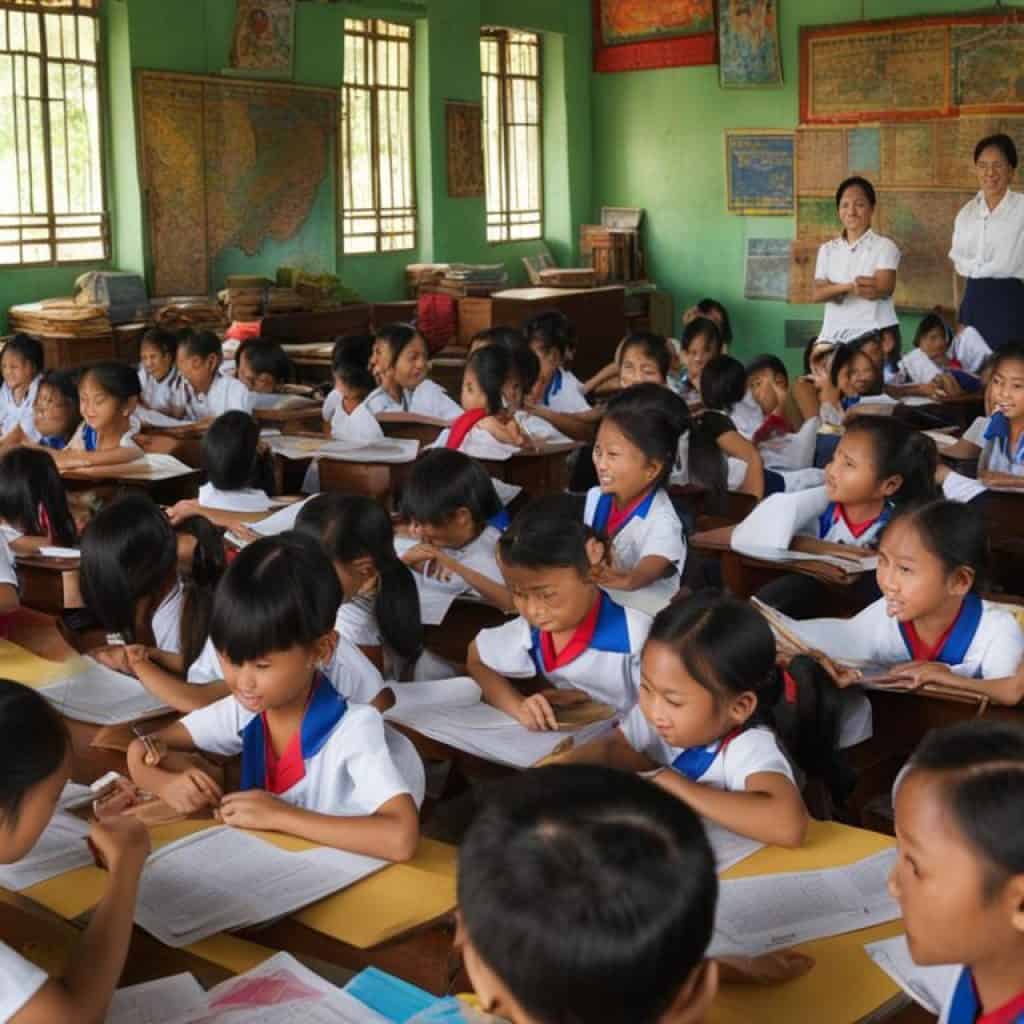
Philippines Facts: Cuisine and Food
Filipino cuisine is a delightful blend of flavors, known for its unique and mouthwatering dishes. From savory to sweet, traditional Filipino cuisine offers a wide range of culinary delights that captivate the taste buds.
Traditional Filipino Dishes
Traditional Filipino dishes are a reflection of the country's rich cultural heritage and diverse influences. Some popular examples include:
- Adobo: A flavorful dish made with meat (usually pork or chicken) cooked in vinegar, soy sauce, garlic, and various spices.
- Sinigang: A tangy soup made with tamarind, tomatoes, and various vegetables, often combined with pork or shrimp.
- Bibingka: A traditional rice cake made with rice flour, coconut milk, eggs, and topped with salted duck eggs and grated coconut.
- Puto Bumbong: A purple-colored rice cake steamed in bamboo tubes, often served during Christmas season.
- Sisig: A sizzling dish made with chopped pig's head and liver, seasoned with calamansi, chili peppers, and onions.
- Lechon: A whole roasted pig, typically seasoned with herbs and spices, resulting in tender meat with crispy skin.
- Menudo: A hearty stew made with pork, liver, potatoes, carrots, and peas, cooked in tomato sauce and spices.
- Caldereta: A flavorful meat stew made with beef or goat, cooked in tomato sauce, liver spread, and various vegetables.
Filipinos take pride in their creativity in the kitchen, resulting in an abundance of delicious dishes. Local ingredients, such as coconut, fish, rice, and tropical fruits, play a significant role in Filipino cuisine, enhancing the flavors and adding a distinct touch to each dish.
Coconut: A Staple and Export Product
Coconut is one of the Philippines' top export products and an integral ingredient in many traditional dishes. The Philippines is the second-largest producer of coconut products globally, with coconut milk, coconut oil, and desiccated coconut being widely used in Filipino cooking.
The Importance of Rice
In Filipino cuisine, rice is a staple and is considered an essential part of every meal. In fact, almost 99% of the population considers a meal incomplete without rice. Filipinos have various rice dishes, including steamed rice, garlic rice, and fried rice. Rice is often paired with other dishes, providing a satisfying and filling meal.
Whether indulging in traditional Filipino delicacies or exploring modern culinary inventions, the Philippines offers a gastronomic adventure for food lovers. The diverse flavors, unique ingredients, and mouthwatering dishes make Filipino cuisine a must-try for anyone visiting the country.
Philippines Facts: Natural Resources and Wildlife
The Philippines is blessed with abundant natural resources and is home to diverse flora and fauna. With over 7,000 islands, this archipelagic nation boasts a rich biodiversity that attracts nature enthusiasts from around the world.
When it comes to wildlife, the Philippines is a treasure trove of endemic species. Among the more than 200 species of mammals found here, you'll encounter playful monkeys, graceful squirrels, charming lemurs, and majestic deer. Two notable creatures native to the Philippines are the binturong, also known as the Asian bear cat, and the tamaraw, a small water buffalo species.
The Philippines is also a paradise for birdwatchers, as it is home to hundreds of avian species. The most famous, and endangered, among them is the Philippine eagle. With its striking appearance and impressive wingspan, this majestic bird is a symbol of the country's commitment to wildlife conservation.
"The Philippines is a biodiversity hotspot, with unique species found nowhere else on Earth. It is a testament to the country's ecological wealth."
In addition to its exceptional wildlife, the Philippines possesses a wide array of natural resources. It is one of the world's top producers of coconuts, and coconut products such as oil and copra contribute significantly to the economy. The country is also known for its bountiful harvests of essential crops like rice, corn, mangoes, pineapples, and sugarcane. When it comes to livestock, pork and beef production thrives, ensuring a steady supply of high-quality meats.
| Resources | Contributions |
|---|---|
| Coconut | Top producer, global supplier of coconut products |
| Rice | Staple food, self-sufficiency in production |
| Corn | Alternative staple, livestock feed |
| Fish | Abundant coastal waters, seafood export |
| Mangoes | Delicious fruit, export quality |
| Pineapples | Export quality, key ingredient in various dishes |
| Sugarcane | Refined sugar production, sweetener |
| Pork | Thriving industry, local and export demand |
| Beef | Domestic consumption, local production |
These natural resources not only sustain the people of the Philippines but also contribute to the country's economic growth and development. They serve as pillars for various industries, including agriculture, food processing, and export trade.
Exploring the natural wonders and wildlife of the Philippines provides a unique opportunity to connect with nature and appreciate the country's incredible biodiversity. From the lush rainforests to the thriving coastal ecosystems, every corner of this island nation is teeming with life and waiting to be discovered.
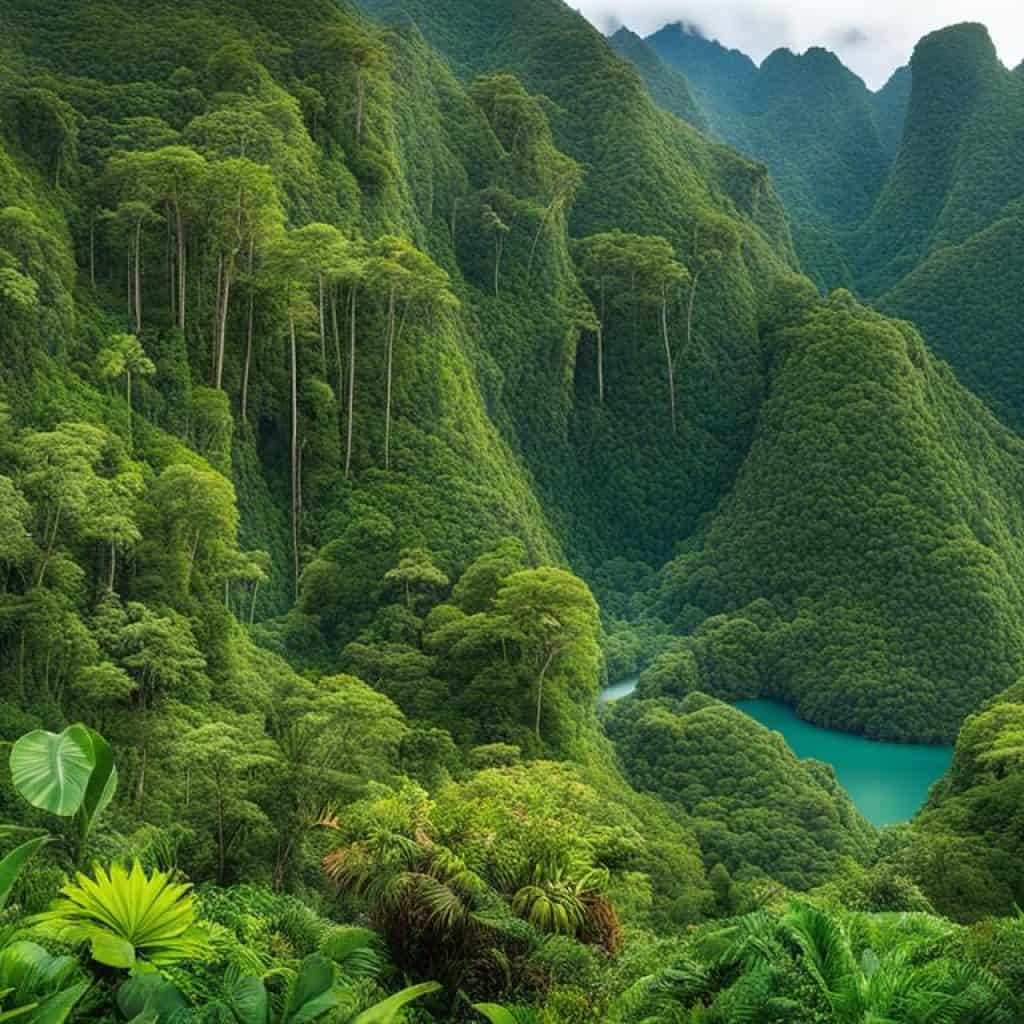
Philippines Facts: Technology and Communication
The Philippines is at the forefront of technology and communication advancements, making it a dynamic and connected country. With its increasing reliance on digital platforms, the Philippines has earned the title of the "text capital of the world." This is due to the massive volume of text messages exchanged by its residents on a daily basis. Text messaging and social media platforms have become the primary means of communication for many Filipinos.
With a population that embraces new technologies, the Philippines has witnessed the emergence of a thriving tech industry. Startups and innovation centers are popping up across the country, fostering a culture of technological innovation and entrepreneurial spirit. Filipinos are known for their tech-savviness and willingness to adopt and adapt to the latest digital advancements in their daily lives.
Despite the archipelagic nature of the Philippines, technological advancements and infrastructure development have facilitated seamless communication across the country. This has revolutionized business operations, education, and personal connections. The digital landscape continues to evolve rapidly, opening new opportunities for growth and development.
Impacts on Communication and Connectivity
"Technology has bridged the gap in communication, connecting even the most remote corners of the Philippines. It has transformed the way Filipinos interact with one another, breaking down barriers and enabling more accessible and efficient communication channels."
Technological advancements have revolutionized communication in the Philippines, making it more accessible and inclusive. Internet connectivity has vastly improved, allowing individuals from different regions to connect effortlessly. This has had a profound impact on various sectors, including education, healthcare, and business.
The widespread use of mobile devices has brought about a significant shift in the way Filipinos communicate. Text messaging, through SMS or messaging apps, has become the preferred mode of communication for many. It provides a convenient and cost-effective means of staying in touch with family, friends, and colleagues, particularly in areas with limited internet access.
The influence of social media platforms cannot be ignored when discussing communication in the Philippines. Filipinos are active users of platforms like Facebook, Instagram, and Twitter, using them to share updates, exchange messages, and engage with communities. Social media has enabled Filipinos to stay connected, regardless of physical distance, and has given rise to new forms of digital expression and connectivity.
Online communication platforms, such as video conferencing and instant messaging apps, have also gained popularity, especially in the professional sphere. They facilitate remote collaboration and enable businesses to connect with clients and partners both locally and internationally. The growth of these platforms has made distance less of a barrier and has spurred economic growth in various industries.
The Future of Technology in the Philippines
"The future of technology in the Philippines holds great promise. As the country continues to invest in innovation and digital infrastructure, it is poised to become a key player in the global tech market. The relentless pursuit of digital transformation will shape the future of communication and technology in the Philippines."
The Philippines has recognized the importance of technology and its role in driving economic growth and development. The government, in collaboration with the private sector, is working towards creating an ecosystem that supports innovation and entrepreneurship. Initiatives such as startup incubators, accelerators, and tech hubs are sprouting up, providing support and resources for aspiring entrepreneurs.
The Philippines' tech industry is thriving, with a growing number of tech startups and homegrown innovations. Filipino talent in the fields of software development, artificial intelligence, and e-commerce are gaining recognition on the global stage. As more investors and venture capitalists recognize the potential of the Philippine tech market, the industry will continue to flourish.
Looking ahead, the Philippines is well-positioned to make significant contributions to the global technology landscape. With a tech-savvy population, a supportive ecosystem, and a culture of innovation, the future of technology and communication in the Philippines is bright.
| Benefits of Technology and Communication in the Philippines | Challenges Faced |
|---|---|
|
|
Philippines Facts: Sports and Entertainment
Sports and entertainment are integral aspects of Filipino culture, showcasing the nation's passion and enthusiasm. The Philippines has a deep love for basketball, a sport that has captivated the hearts of many Filipinos. In fact, the country holds the distinction of founding Asia's very first basketball league, the Philippines Basketball Association, in 1975. Basketball courts can be found in every corner of the Philippines, from bustling cities to remote villages, with Filipinos of all ages passionately playing the game.
One individual who has brought immense pride to the Philippines through his boxing prowess is none other than Manny Pacquiao. His extraordinary achievements in the boxing ring have garnered international acclaim and solidified his status as a national hero. Pacquiao's legendary career has inspired countless aspiring athletes and has placed the Philippines firmly on the global sporting map.
Aside from sports, the Philippines boasts a vibrant entertainment industry that encompasses music, film, and television. Filipino artists have made significant contributions to the world of entertainment, captivating audiences with their talent and creativity. The Philippines is home to iconic singers, actors, and filmmakers who have achieved success both domestically and internationally.
Karaoke is another cultural phenomenon deeply embedded in Filipino entertainment. Singing is a favorite pastime for Filipinos, and karaoke machines can be found in homes, bars, and public spaces throughout the country. Filipinos revel in showcasing their vocal prowess, gathering with friends and family to belt out their favorite tunes, making karaoke an integral part of Filipino social gatherings.
| Sports in the Philippines | Entertainment in the Philippines |
|---|---|
|
|
With its vibrant sports scene and thriving entertainment industry, the Philippines offers a wealth of opportunities for sports enthusiasts and entertainment aficionados alike. Whether cheering for their favorite basketball team or immersing themselves in the captivating world of Filipino cinema, visitors to the Philippines are guaranteed an unforgettable experience.
Philippines Facts: Tourism and Landmarks
The Philippines is a destination that offers a myriad of tourist attractions and famous landmarks, making it a must-visit place for travelers. With its stunning beaches, picturesque islands, and rich cultural heritage, the country has something to offer for every type of traveler.
- Tourist Attractions: The Philippines is home to a wide range of tourist attractions that cater to different preferences. Some popular destinations include:
- Boracay: Famous for its pristine white sand beaches and turquoise waters, Boracay is a paradise for beach lovers.
- Palawan: Known for its breathtaking natural beauty, Palawan is home to the iconic Puerto Princesa Subterranean River, a UNESCO World Heritage Site.
- Manila: The capital city of the Philippines offers a blend of history, culture, and modern attractions, including the historic Intramuros and the vibrant nightlife of Makati.
- Cebu: With its stunning beaches and vibrant marine life, Cebu is a popular destination for snorkeling, diving, and island hopping.
- Baguio: Known as the "Summer Capital of the Philippines," Baguio offers a cool climate, beautiful landscapes, and cultural attractions, including the colorful Panagbenga Festival.
"The Philippines is a land of enchantment, offering a diverse array of destinations that will leave you in awe."
- Famous Landmarks: The Philippines boasts several famous landmarks that showcase the country's rich history and natural wonders. Some iconic landmarks include:
- Puerto Princesa Subterranean River: Located in Puerto Princesa, Palawan, this underground river is one of the New Seven Wonders of Nature, with stunning rock formations and unique wildlife.
- Chocolate Hills: Found in Bohol, these perfectly cone-shaped hills turn chocolate brown during the dry season, creating a mesmerizing sight.
- Banaue Rice Terraces: Carved into the mountains of Ifugao, these terraces are a testament to the ingenuity of the indigenous people and are often referred to as the "Eighth Wonder of the World."
The Philippines is also a haven for outdoor enthusiasts, offering a wide range of activities such as diving in world-class dive spots, hiking up majestic mountains, and exploring hidden islands. It is a nation filled with fascinating people, cultures, and hidden gems waiting to be discovered.
| Tourist Attractions | Famous Landmarks |
|---|---|
| Boracay | Puerto Princesa Subterranean River |
| Palawan | Chocolate Hills |
| Manila | Banaue Rice Terraces |
| Cebu | |
| Baguio |
Conclusion
The Philippines is a treasure trove of fascinating facts and insights, offering a multitude of experiences for every visitor. With its breathtaking landscapes, rich history, vibrant culture, and abundant natural resources, the country never fails to amaze. Whether you're immersing yourself in the stories of its past, savoring the diverse flavors of its cuisine, or exploring its stunning wonders, the Philippines invites you to embark on an unforgettable journey.
Renowned for its warm hospitality, the Philippines welcomes travelers with open arms. Each island reveals a unique charm, from the idyllic white sand beaches and crystal-clear waters of Boracay and Palawan to the bustling city life of Manila and Cebu. With famous landmarks such as the Puerto Princesa Subterranean River and the awe-inspiring Chocolate Hills, the country promises travelers a wealth of sights to behold.
But the enchantment of the Philippines goes far beyond its physical wonders. It resides in the hearts and souls of its people, who are known for their kindness, resilience, and love for life. The warm smiles and genuine hospitality of Filipinos will leave an indelible mark on your journey. The Philippines is a nation that embraces diversity, celebrates its rich cultural heritage, and cherishes the traditions that have been passed down through generations.
So, why wait? Plan your visit to the Philippines and uncover more captivating facts and insights that will spark your sense of adventure. Delve into its vibrant history, immerse yourself in its cultural tapestry, and immerse yourself in the natural wonders that make this country truly extraordinary. The beauty, charm, and warmth of the Philippines await you, ready to create memories that will last a lifetime.
FAQ
What are some interesting facts about the Philippines?
The Philippines is an archipelago composed of 7,641 islands, making it one of the largest archipelagos in the world. It is known as the "text capital of the world" due to the large volume of text messages sent throughout the country. The Philippines is the only Asian nation that is predominantly Christian, with 86 percent of the population being Roman Catholic. Three of the world's largest shopping malls can be found in the Philippines. The country is one of the largest producers of coconuts and is also known for its mangosteens, papayas, and bananas. The Philippines is home to the world's largest pearl, valued at $100 million. It is the 13th-most populous country in the world, with a population of over 108 million people. The Philippines Basketball Association was the first basketball league in Asia. The country is the largest supplier of nurses worldwide, partially due to limited job opportunities locally.
Where is the Philippines located?
The Philippines is an archipelago located in Southeast Asia. It is composed of 7,641 islands, making it one of the largest archipelagos in the world. The two largest islands, Luzon and Mindanao, make up two-thirds of the total land area. Only about one-third of the islands are inhabited. The Philippines is situated between the South China Sea and the Pacific Ocean. It has a total land area of about 115,831 square miles (300,000 square kilometers). The country has a diverse range of landscapes, including beautiful beaches, mountains, volcanoes, and rainforests. The islands are home to numerous species of flora and fauna, including orchids, monkeys, squirrels, lemurs, and a variety of bird species.
What is the history of the Philippines?
The Philippines has a rich history that dates back centuries. It was first visited by Ferdinand Magellan in 1521, and the name "Philippines" was given in honor of Philip II of Spain. The country became a Spanish colony in the 16th century and was ruled by Spain for over 300 years. It was granted to the United States in 1898 after the Spanish-American War. The Philippines became self-governing in 1935, but its independence was delayed by World War II and the invasion of Japanese troops. The islands were eventually liberated by U.S. forces in 1944-45, and the Republic of the Philippines was proclaimed in 1946. The country has since experienced periods of martial law and democratic rule, with significant political and social changes over the years.
What is the culture of the Philippines like?
The Philippines has a vibrant and diverse culture influenced by its history of colonization and indigenous traditions. Filipino cuisine is a reflection of this cultural diversity, with dishes such as adobo, sinigang, and lechon being popular. The Philippines is known for its love of music and singing, with karaoke being a beloved pastime for many Filipinos. The country has a strong emphasis on English education, making it one of the largest English-speaking countries in the world. Filipinos are also known for their hospitality and respect for elders, with terms like "ate" and "kuya" used to address older siblings or elders. Superstitions also play a significant role in Filipino culture, influencing various aspects of daily life and traditions.
What are some unique facts about the Philippines?
The Philippines is a country filled with unique aspects that set it apart from other nations. Some of these include the iconic jeepney, colorfully painted buses with roots dating back to World War II. The country is also home to the endangered Philippine eagle, known for its majestic appearance and habitat in the rainforests of the Philippines. The Philippines is the largest supplier of nurses worldwide, with many Filipinos seeking work abroad due to limited job opportunities locally. The largest underground river can be found in the Philippines, located in Puerto Princesa Subterranean River National Park. The country also has unique transportation modes, such as tricycles and kalesas.
What are some surprising facts about the Philippines?
The Philippines is full of surprising facts that captivate the imagination. For example, the country has over 170 dialects, showcasing its linguistic diversity. Filipinos are known for their love of selfies, ranking as the highest selfie-takers in the world. The famous street snack in the Philippines is balut, which is a fertilized duck embryo. Christmas celebrations in the Philippines begin in September and last until January, known as the "Feast of the Three Kings." The Philippines is also known for its superstitions and beliefs, with a significant portion of the population holding strong superstitious beliefs.
What is the education system like in the Philippines?
The education system in the Philippines starts with elementary education at the age of seven, followed by secondary education at the age of 13. Undergraduate college instruction typically lasts for four years. The official language of the Philippines is Filipino, which is based on Tagalog. However, English is widely spoken and is the second official language. The Philippines ranks as the fifth-largest English-speaking country globally, making communication with locals easy for English speakers.
What is Filipino cuisine like?
Filipino cuisine is known for its unique and delicious flavors. Some traditional Filipino dishes include adobo, sinigang, bibingka, puto bumbong, sisig, lechon, menudo, and caldereta. Filipinos are creative in the kitchen, using a variety of local ingredients to create flavorful and satisfying dishes. Coconut is a top export product of the Philippines, with the country being the second-largest producer of coconut products globally. Rice is a staple in Filipino cuisine, with almost 99% of the population considering a meal incomplete without it.
What are the natural resources and wildlife in the Philippines?
The Philippines is rich in natural resources and is home to diverse flora and fauna. The country has over 200 species of mammals, including monkeys, squirrels, lemurs, and deer. The binturong, or Asian bear cat, and the tamaraw, a species of small water buffalo, are native to the Philippines. The country is also a haven for bird species, with hundreds of species residing in the Philippines, including the endangered Philippine eagle. The Philippines' natural resources include coconut, rice, corn, fish, mangoes, pineapples, sugarcane, pork, and beef.
What is the technology and communication like in the Philippines?
The Philippines is known for its advancements in technology and communication. It has earned the title of the "text capital of the world" due to the large volume of text messages sent throughout the country. Social media and texting are the primary means of communication for many Filipinos. The country also has a growing tech industry, with startups and innovation centers emerging. Filipinos are tech-savvy and embrace new technologies in their daily lives.
What is the role of sports and entertainment in Filipino culture?
Sports and entertainment play significant roles in Filipino culture. Basketball is a beloved sport in the Philippines, and the country founded Asia's first basketball league, the Philippines Basketball Association, in 1975. Filipino boxers, such as Manny Pacquiao, have achieved international fame and have become national heroes. The Philippines has a vibrant entertainment industry, with a thriving music, film, and television scene. Karaoke is a popular pastime, with Filipinos showcasing their vocal talents at gatherings and parties.
What are some popular tourist destinations in the Philippines?
The Philippines is a major tourist destination known for its stunning beaches, picturesque islands, and rich cultural heritage. Popular tourist attractions include Boracay, Palawan, Manila, Cebu, and Baguio. The country is home to famous landmarks such as the Puerto Princesa Subterranean River, the Chocolate Hills in Bohol, and the Banaue Rice Terraces. The Philippines offers a wide range of outdoor activities, including diving, hiking, and island hopping. It is a nation filled with fascinating people, cultures, and hidden gems waiting to be discovered.
